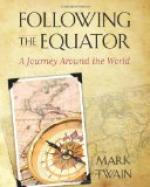The next game would end tournament No. 1.
Mr. Thomas and I were the contestants. He won the lead and went to the bat—so to speak. And there he stood, with the crotch of his cue resting against his disk while the ship rose slowly up, sank slowly down, rose again, sank again. She never seemed to rise to suit him exactly. She started up once more; and when she was nearly ready for the turn, he let drive and landed his disk just within the left-hand end of the 10. (Applause). The umpire proclaimed “a good 10,” and the game-keeper set it down. I played: my disk grazed the edge of Mr. Thomas’s disk, and went out of the diagram. (No applause.)
Mr. Thomas played again—and landed his second disk alongside of the first, and almost touching its right-hand side. “Good 10.” (Great applause.)
I played, and missed both of them. (No applause.)
Mr. Thomas delivered his third shot and landed his disk just at the right of the other two. “Good 10.” (Immense applause.)
There they lay, side by side, the three in a row. It did not seem possible that anybody could miss them. Still I did it. (Immense silence.)
Mr. Thomas played his last disk. It seems incredible, but he actually landed that disk alongside of the others, and just to the right of them-a straight solid row of 4 disks. (Tumultuous and long-continued applause.)
Then I played my last disk. Again it did not seem possible that anybody could miss that row—a row which would have been 14 inches long if the disks had been clamped together; whereas, with the spaces separating them they made a longer row than that. But I did it. It may be that I was getting nervous.
I think it unlikely that that innings has ever had its parallel in the history of horse-billiards. To place the four disks side by side in the 10 was an extraordinary feat; indeed, it was a kind of miracle. To miss them was another miracle. It will take a century to produce another man who can place the four disks in the 10; and longer than that to find a man who can’t knock them out. I was ashamed of my performance at the time, but now that I reflect upon it I see that it was rather fine and difficult.
Mr. Thomas kept his luck, and won the game, and later the championship.
In a minor tournament I won the prize, which was a Waterbury watch. I put it in my trunk. In Pretoria, South Africa, nine months afterward, my proper watch broke down and I took the Waterbury out, wound it, set it by the great clock on the Parliament House (8.05), then went back to my room and went to bed, tired from a long railway journey. The parliamentary clock had a peculiarity which I was not aware of at the time —a peculiarity which exists in no other clock, and would not exist in that one if it had been made by a sane person; on the half-hour it strikes the succeeding hour, then strikes the hour again, at the proper time. I lay reading and




